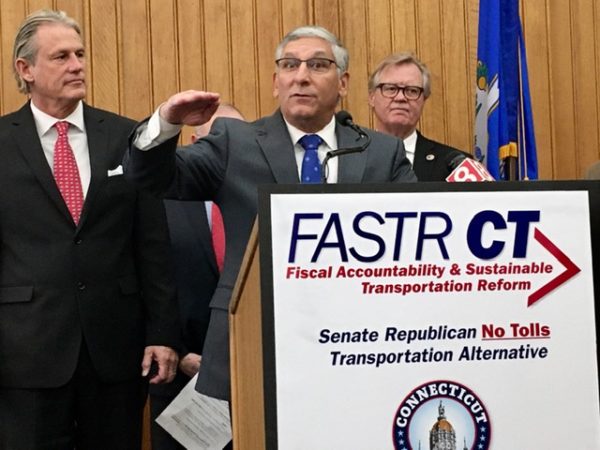Senate GOP’s No-Tolls Alternative Relies on Rainy Day Fund

Audio By Carbonatix

Senate GOP leader Len Fasano outlines the Republican alternative to tolls. Photo credit: Mark Pazniokas, CTMirror.org
Lamont would have to bend on a key fiscal principle.
By Keith M. Phaneuf and Mark Pazniokas, CTMirror.org
The Senate Republican minority on Thursday proposed using budget reserves in a complex and creative way to finance an overhaul of Connecticut’s creaky transportation system without tolls or new taxes, inviting Gov. Ned Lamont and Democratic lawmakers to weigh those political advantages against sacrifices and risks inherent in the plan.
The GOP would use nearly two-thirds of the state’s budget reserves to pay down pension liabilities, producing an annual savings of $130 million that could be spent on transportation. Another $100 million would come from cutting annual borrowing for things such as capital spending on local schools and public universities.
The economic and political risks would be significant. Connecticut would lose borrowing capacity to meet other needs, and it would leave itself vulnerable in a recession. Politically, it would require Lamont to compromise one of his first principles: The importance of resisting the temptation to spend the reserves.
The governor and Democratic lawmakers responded cautiously, praising Senate Minority Leader Len Fasano, R-North Haven, for recognizing the importance of transportation investment, but stopping well short of endorsing tapping reserves.
“While I appreciate Senator Fasano’s proposal to partially fund much-needed infrastructure investments, taking money out of the Rainy Day Fund is a risky proposition that requires serious evaluation,” Lamont said.
The governor has been insistent since he took office in January on building a cushion against the next recession.
“There’s a tendency to want to spend [the reserves] and defer the tough choices we know we have to make,” Lamont told CT Mirror in a post-election interview a year ago. “But you know how volatile our income taxes can be. If the bottom falls out … we ought to be ready.”
Fasano has been working on the alternative for weeks, but the time of its completion could be propitious, coming a day after Senate Democrats took tolls off the table as a financing mechanism.
“We recognize the the hard work that Gov. Lamont has put into his CT2030 plan, but we do not support tolls, which is why we worked to offer this no-tolls alternative,” Fasano said in unveiling the GOP alternative, FASTR CT. “We developed FASTR CT to show there is another way to invest in transportation and grow jobs in a manner that is sustainable and accountable to taxpayers — all without tolls.”
Lamont greatly scaled back the tolls in his original plan proposed in February, instead seeking 14 highway tolls that would provide $320 million in annual revenue — a dedicated revenue stream needed to leverage low-cost financing for $21 billion in transit and highway improvements over 10 years.
The GOP’s alternative echoes several of the non-tolls elements of Lamont’s latest transportation initiative, including reliance on low-interest federal financing and an aggressive transfer of sales tax receipts from the budget’s General Fund into the transportation program.
With a cash flow of $230 million, however, the GOP plan would produce only 70% of the revenue projected from Lamont’s tolls plan, necessitating a downsizing of some of the projects in his plan, CT2030.
But the GOP says it still could finance $18 billion in transportation spending over the next decade, giving Lamont a significant portion of transportation improvements he says are vital to spark economic growth and keep the state in the running for obtaining cheap federal financing.
The construction industry, which has seen a loss of jobs in the past year, reacted positively, if cautiously.
“I think it’s encouraging,” said Nate Brown of the International Union of Operating Engineers, one of the building trades desperate for more work. “It should be looked at.”
“I think this is a very interesting discussion today,” said Don Shubert, the president of Connecticut Construction Industry Association, “And it’s very, very encouraging for anybody that’s a transportation advocate to see the discussion at this level.”
Whether the plan would be embraced by the Democratic majority was unclear. Legislators echoed the administration in saying there was much to review, praising Fasano for playing a constructive role and sounding a note of caution.
“Our transportation infrastructure is decaying and in need of historic investments so it is important to listen to all ideas and potential solutions,” said House Speaker Joe Aresimowicz, D-Berlin. “I am still reviewing Senator Fasano’s proposal; however, I do have concerns about such a significant raid on the rainy day fund as the cornerstone of the funding plan.”
House Minority Leader Themis Klarides, R-Derby, whose relationship with Fasano has been strained at times, was complimentary of the alternative produced by Republican senators without House GOP involvement.
“The Senate Republican transportation initiative represents an alternative to the governor’s that allows for significant investments in our infrastructure without asking motorists and taxpayers to pay tolls,” Klarides said.
Her own caucus, she said, was working on a similar plan.
Converting pension woes into a transportation plus
Just how would Senate Republicans use Connecticut’s cash-starved state employee pension fund – which suffers from seven decades of poor savings habits – into an asset for transportation?
It’s complicated, but step one is to crack open the $2.5 billion budget reserves set aside by the administrations of Lamont and former Gov. Dannel P. Malloy over the past two years.
Connecticut has yet to recover all jobs lost in the Great Recession of 2008. Most of the reserve is due to surging income tax receipts tied to capital gains, rather than from broad economic growth.
Still, $2.5 billion in the rainy day fund – equal to 13% of annual operating costs – easily shatters the last record reserve of $1.4 billion, or 8%, held back in 2008.
The Senate GOP would take $1.5 billion of that reserve and deposit it into the pension fund.
Why not just assign it straight to the budget’s Special Transportation Fund? Because that would push spending this year, and likely in subsequent years, over the statutory spending cap, which Republicans say they won’t break.
But pension contributions are cap exempt. And as pension fund assets rise, required contributions going forward shrink.
A $1.5 billion infusion won’t come close to solving all of the state’s pension woes. But nonpartisan analysts project it would justify reducing annual contributions by $130 million.
These funds then would be redirected to transportation. And like Lamont planned for some of his toll receipts, Republicans also would use this pension savings and some other resources in the Special Transportation Fund to pay cash for many infrastructure projects — sparing Connecticut hundreds of millions of dollars in interest costs over the coming decade.
“This is not a raid on the budget reserve,” Fasano said. While legislators and governors in the 1990s and 2000s routinely used reserves for one-time expenses, this proposal, Fasano said respects taxpayers by reducing debt and accelerating a transportation rebuild.
“This is the way you give it back to them: an investment in the state of Connecticut to get the state of Connecticut to grow.”
Add a little bit of ‘Prioritize Progress’
But the pension pay-down still wouldn’t free up enough resources to do the entire job.
Connecticut’s transportation capital program barely maintains the state of good repair of its highways, bridges and rail lines, allowing little funding for strategic enhancements to reduce congestion.
The next step in the Senate Republican plan finds more resources to tackle this priority by reviving and modifying an earlier proposal it called “Prioritize Progress.”
Rather than charge motorist fees, Republicans suggested Connecticut redirect hundreds of millions of dollars in borrowing from school construction, higher education, state building renovations, community-based projects and other initiatives into transportation. Democrats said the plan would cause as many problems as it solved.
But for FASTR CT to work, Republicans now say they need just $100 million per year from this area. Hoping to win Lamont’s approval, the GOP notes this approach still would accommodate the governor’s proposal for a “debt diet.”
Lamont wants to curb borrowing in non-transportation areas by as much as $500 million per year, though he’s struggled to win support for this idea from his fellow Democrats in the House and Senate majorities.
Senate Republicans say that while they would need to redirect $100 million of this bonding for transportation, Lamont still could make major reductions in non-transportation bonding and not impact their program.
The Senate GOP proposal also would restore a 2018 bipartisan plan to increase the share of sales tax receipts dedicated to the Special Transportation Fund. Lamont and the legislature’s Democratic majority had scaled back the transfer considerably in the most recent two-year state budget, adopted back in June.
Like Lamont, the Senate Republican plan also counts on securing low-interest financing through two federal programs that allow the loans to be repaid over a period as long as 27 years.
Fasano praised the Democratic governor for forcing an overdue debate on rebuilding Connecticut’s aging, overcrowded transportation system.
“I applaud the governor because he has done something no other governor has done,” Fasano said, adding Lamont developed a holistic and methodical plan.
“He’s doing it the right way,” Fasano added. “We use his construction plan and figure out a way to pay for it” without tolls.
And while the $18 billion the GOP plan would invest in transportation upgrades by 2030 — $19 billion, Republicans say, if the most favorable federal rates could be obtained — doesn’t match the $21 billion Lamont proposed, it comes close.
But that comparison can be deceiving.
Transportation officials say about $15.6 billion is needed over the next decade just to keep infrastructure in good shape. Any strategic improvements — widening highways, adding rail cars, redesigning interchanges — would cost more.
Lamont’s plan would invest $5.4 billion above the $15.6 billion threshold, while the GOP plan would only go $2.4 billion past it.
“We are not DOT experts,” Fasano said. “We don’t profess to be.”
But the Senate Republcian leader said the GOP plan still spares Connecticut motorists form paying tolls and makes a significant new investment in transportation.
Republicans also proposed assembling engineers, construction business representatives, transportation advocates and other professionals to ensure the most important projects are moving forward.
The GOP would reassemble the Transportation Strategy Board, a state panel that existed in the early 2000s. This team of experts would vet all transportation projects and offer assessments.
Senate Republicans also proposed creating a second strategy panel, with officials from Connecticut and New York, to provide similar oversight of all rail projects – particularly those with the commuter service linking Connecticut’s shoreline with New York City.
Selling the plan to Lamont … and to Wall Street
But to make it all work, Republicans have one more step to take.
The GOP also has to convince Lamont and Democratic lawmakers to gamble on using the reserves with the hope they could be restored before the next downturn hits.
At the same time, officials also would need to convince Wall Street credit rating agencies – whose reports determine whether Connecticut can borrow funds cheaply – that this makes good fiscal sense. The Lamont administration already is trying to gauge how Wall Street would weigh accelerating the payment of pension debt against exposure from a recession.
Taking $1.5 billion from a $2.5 billion rainy day fund still leaves a lot.
But $1 billion doesn’t go as far as it used to.
When the last recession ended in 2010, annual tax receipts were $1.6 billion less than they were two years earlier, just before the downturn began.
And a national poll released Monday by CNBC found two-thirds of Americans surveyed believe the U.S. economy will enter another recession within the next year, while a monthly worldwide report by Bank of America Merrill Lynch finds money managers heartened by a pause in the U.S.-China trade war and optimistic of continued growth.
Republicans said investing reserves in the pension would make financial sense, even facing some fears of recession. Beside bolstering a fund short-changed almost every year between 1939 and 2010, it would produce a larger return.
Dollars in the budget reserve must be kept fairly liquid, and likely would earn little more than 2% interest per year, Republicans said. By comparison, the assumed rate of return on pension investments is an average of 6.9% per year.
More importantly, Senate Republicans noted, Lamont’s own projections say the reserve isn’t done growing.
Both the governor’s budget office and the legislature’s nonpartisan Office of Fiscal Analysis estimate Connecticut will deposit $300 million more into the reserve next September once the audit of the 2019-20 fiscal year has ended.
And while Republican legislators wouldn’t predict what will happen with the nation’s economy a year from now, they noted that analysts project another $450 million will be added to Connecticut’s reserves by the fall of 2021.
But those are only projections and there are no guarantees Connecticut’s coffers will continue to grow.
Fasano added, though, that the legislature is better prepared to respond to the next recession than its 2008 counterpart did.
“Everything in life is a risk,” he said. “Nothing is 100 percent.”
But the 2008 General Assembly “refused to act quickly and cut spending” as signs of budget weakness grew, Fasano said.
In addition, the budget now includes stronger caps on spending and borrowing. It also features a “volatility adjustment” program that forces the state to save more whenever income tax receipts from capital gains exceed a certain threshold level.
“I think we are protected,” Fasano said.
Reprinted with permission of The Connecticut Mirror. The authors can be reached at [email protected] and [email protected] .
Like what you see here? Click here to subscribe to We-Ha’s newsletter so you’ll always be in the know about what’s happening in West Hartford!



